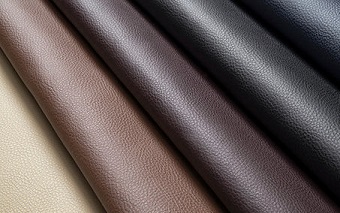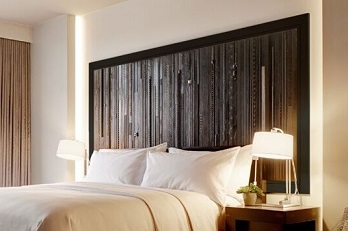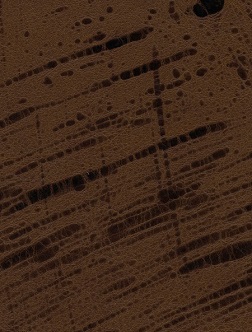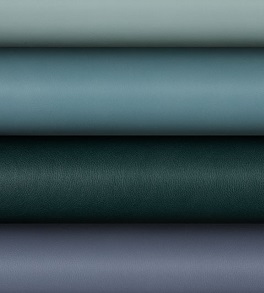
NATIONAL REPORT—As many activist groups continue to condemn the use and production of leather for ethical, environmental and worker health reasons, this byproduct of meat production is commonly found in the hotel industry.
“It is used anywhere where people use wood—tabletops, floors, headboards, restaurant walls, some ceilings as well,” says Christian Nadeau, President of EcoDomo LLC. “It is primarily used for upholstery in hospitality. It is not only used in luxury hotels. Adding a touch of leather adds elegance to a product.”
Increasingly, companies serving the hotel industry have been promoting their leather as a green product. How can that be? Green Lodging News examined 10 leather companies to determine exactly what makes their products sustainable. In all cases it came down to how long leather lasts, how leather is processed and how leather scraps are repurposed.
EcoDomo, for example, makes its leather products from scraps from the shoe and car seat industries. The leather Nadeau’s company uses is vegetable tanned. The tanning process is much longer compared to when chromium is used. Vegetable tanning, however, is not environmentally harmful. Chrome tanned leather is leather produced using a solution of chemicals, acids and salts to dye the hide. It is cheap, quick and mass produced. Chrome, like any heavy metal, is extremely toxic and environmentally damaging, thus creating wastewater leftovers that are very toxic.
Certifications to look for when purchasing leather include GREENGUARD Certification. GREENGUARD ensures that a product has met some of the world’s most rigorous and comprehensive standards for low emissions of volatile organic compounds (VOCs) into indoor air. The LEATHER STANDARD by OEKO-TEX is a worldwide consistent, independent testing and certification system for leather and leather articles of all levels of production.

Leather Product Suppliers
EcoDomo is an expert with leather surfacing—recycled and hide leather applied to a variety of substrates and formats. EcoDomo has since expanded its lines to include a leather veneer, a collection of interlocking planks, decorative borders, laminated leathers and extensive custom design options. EcoDomo’s Rainforest Collection, for example, is a 2 mm recycled leather made from pulverized leather fibers extracted from car seat and other leather tanneries. It can be used for floors, walls and extreme wear applications. The Rainforest Collection leathers are available as sheets, tiles, laminated panels or floating floors. EcoDomo also partners with manufacturers to integrate leather into their products as a supplier.
“I sleep better because it is all made of waste,” Nadeau says.
EcoDomo’s operations are “carbon neutral.” The company invests in the replanting of trees to offset the carbon dioxide it generates through its travels, the products it imports, and the operation of the company. “We see it as a cost of doing business,” Nadeau says.
Leather Fiber Mixed with Synthetic Fiber
LeatherPlus from Enduratex (70 percent leather) is made from leather shavings, trimmings and other leather processing waste that is diverted from landfills. The refined leather fiber is mixed with synthetic fiber. Solvent-free polyurethane is then crosslinked into the fabric and heated between 194 to 212 degrees Fahrenheit. The polyurethane surface allows for coloring and embossing.
According to LDI Corp., EnviroLeather by LDI is “the alternative to faux leather vinyl.” The company offers a collection of PVC-free print patterns to complement a package of solid and textured leather grains in over 100 color choices for its faux leather vinyl alternative fabric. No plasticizers or flame retardants are used and EnviroLeather by LDI has passed indoor air quality testing for low VOC emisssions. Products include no heavy metals, formaldehyde or antimicrobial biocides. As part of a significant waste-saving effort, EnviroLeather by LDI has moved to a print-on-demand model. Produced within a two-week lead-time under a 5-yard minimum, the fabric for each project is made to order. The textile substrates behind the thermoplastic elastomer face of EnviroLeather™ use pre and post-consumer recycled content and renewable, natural content.

Green Hides’ mission addresses sustainability. Green Hides believes that, as the fabric of nature, leather should exist in complete harmony with and respect for the earth and its natural eco-systems. This philosophy underlies Green Hides’ corporate culture, showing up everywhere from conversations on social media to sample production. In 2009, Green Hides’ Italian tannery installed solar panels to power their facility; they use closed loop, low emission processes and water-based finishes, have elaborate recycling and water purification systems in place and have achieved ISO 14001 environmental certification.
Further, in direct collaboration with their partners in Italy, Green Hides developed a new leather product, EcoLife. The collection meets ambitious goals for, for example, chrome-free tanning, solvent-free finishing—and avoids salt treatments and conserves water by using the freshest hides.
American Leather is a founding member of the Sustainable Furniture Council. The leather used on the company’s furniture uses water-based pigments and leather is made through chrome-free processes. American Leather’s manufacturing process minimizes the amount of leather scraps. Any remaining leather scraps are either recycled or resold to produce small leather goods.
American Leather’s central U.S. location in Dallas not only ensures fast product delivery compared to brands manufactured outside the country by reducing travel time, it also yields a smaller carbon footprint than imported goods. In addition, the company conserves energy with automatic light shut-offs and encourages employees to recycle.
Scrap Leather Donated
Garrett Leather, which says leather is an environmentally-friendly option for upholstery, offers GREENGUARD Indoor Air Quality Certified products with no PVCs, BPA, plasticizers, heavy metals, persistent organic pollutants, polybrominated diphenyl ethers, or phthalates. Garrett Leather says its leather lasts up to five times longer than other upholstery materials and reduces replacement costs and unnecessary waste.
“Leather is a byproduct of the food industry,” the company says. Resources utilized would otherwise become landfill. No animal is ever harmed solely for the use of its hide.”
Hides used by Garrett Leather are from farmed animals in Europe. Salt used for preservation is reused. Virtually 100 percent of dyes and other ingredients are absorbed into the leather. Remnant water is treated, and safe, clean water is returned to the environment. Scrap leather is donated to schools and to charitable organizations.

Edelman Leather serves the high-end hospitality market with its wall tiles. All Edelman leathers are GREENGUARD Indoor Air Quality Certified. The tanning process is built mostly around water-based material, therefore limiting emissions of VOCs (Volatile Organic Compounds). Many Edelman leathers are tanned solely with tree bark extracts; i.e. Quebracaho, Mimosa and Oak-Vegetable tannage. Edelman’s finishing Plant in New York State uses no solvent based materials and produces no VOCs as all finishes are water-based and enforced by OSHA.
According to Edelman Leather, full grain leathers, aniline dyed and with small amounts of pigment in the finish, outlast fabrics four to five times. Therefore, the life of a leather chair, even in a hotel lobby, is extended substantially. This eliminates waste, the company says.
Cortina Leathers says it is the first company to introduce chrome-free, environmentally-friendly leather—Ecco-La. Ecco-La is non-polluting and does not emit toxic ashes when incinerated. Cortina Leathers uses dyes, pigments and topcoats that are water based rather than petroleum based.
Keleen Leathers offers its Thrift Recycled Leather Collection in 17 colors.
Willowtex’s “animal friendly” faux leather has been tested for harmful substances using Oeko-Tex Standard 100. According to Willowtex, its IZIT Leather far exceeds the industry standard with over 200,000 double rubs on the Wyzenbeek testing method while the industry standard is 30,000.
Glenn Hasek can be reached at editor@greenlodgingnews.com.






